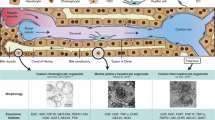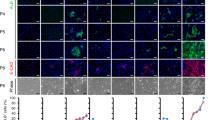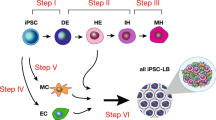Abstract
Donor organ shortage is still the major obstacle for the clinical application of hepatocyte transplantation in the treatment of liver diseases. However, generation of hepatocyte-like cells from mesenchymal stem cells (MSCs) has become a real alternative to the isolation of primary hepatocytes. MSCs are extracted from the tissue by collagenase digestion and enriched by their capacity to grow on plastic surfaces. Enriched cells display distinct mesenchymal surface markers and are capable of multiple lineage differentiation. In the presence of specific growth conditions, the cells adopt functional features of differentiated hepatocytes. After orthotopic transplantation, differentiated human stem cells engraft in the host liver parenchyma of immunocompromized mice. This protocol describes the in vitro differentiation of stem cells from human bone marrow and their transplantation into livers of immunodeficient mice. The cell culture procedures take about 4–5 weeks, and cells engrafted in the mouse liver may be detected 2–3 months after transplantation.
This is a preview of subscription content, access via your institution
Access options
Subscribe to this journal
Receive 12 print issues and online access
$259.00 per year
only $21.58 per issue
Buy this article
- Purchase on Springer Link
- Instant access to full article PDF
Prices may be subject to local taxes which are calculated during checkout




Similar content being viewed by others
References
Smets, F., Najimi, M. & Sokal, E.M. Cell transplantation in the treatment of liver diseases. Pediatr. Transplant. 12, 6–13 (2008).
Alison, M.R., Islam, S. & Lim, S. Stem cells in liver regeneration, fibrosis and cancer: the good, the bad and the ugly. J. Pathol. 217, 282–298 (2009).
Ito, M., Nagata, H., Miyakawa, S. & Fox, I.J. Review of hepatocyte transplantation. J. Hepatobiliary Pancreat Surg. 16, 97–100 (2009).
Oertel, M. & Shafritz, D.A. Stem cells, cell transplantation and liver repopulation. Biochim. Biophys. Acta. 1782, 61–74 (2008).
Puppi, J. & Dhawan, A. Human hepatocyte transplantation overview. Methods Mol. Biol. 481, 1–16 (2009).
Fox, I.J. & Roy-Chowdhury, J. Hepatocyte transplantation. J. Hepatol. 40, 878–886 (2004).
Weber, A., Groyer-Picard, M.-T., Franco, D. & Dagher, I. Hepatocyte transplantation in animal models. Liver Transpl. 15, 7–14 (2009).
Shafritz, D.A., Oertel, M., Menthena, A., Nierhoff, D. & Dabeva, M.D. Liver stem cells and prospects for liver reconstitution by transplanted cells. Hepatology 43, S89–S98 (2006).
Seppen, J., Filali, E.E. & Elferink, R.O. Small animal models of hepatocyte transplantation. Methods Mol. Biol. 481, 75–82 (2009).
Laconi, S. et al. Massive liver replacement by transplanted hepatocytes in the absence of exogenous growth stimuli in rats treated with Retrorsine. Am. J. Pathol. 158, 771–777 (2001).
Laconi, E. et al. Long-term, near-total liver replacement by transplantation of isolated hepatocytes in rats treated with retrorsine. Am. J. Pathol. 153, 319–329 (1998).
Vassilopoulos, G.P., Wang, R. & Russell, D.W. Transplanted bone marrow regenerates liver by cell fusion. Nature 422, 901–904 (2003).
Wang, X. et al. Cell fusion is the principal source of bone-marrow-derived hepatocytes. Nature 422, 897–901 (2003).
Willenbring, H. et al. Myelomonocytic cells are sufficient for therapeutic cell fusion in liver. Nat. Med. 10, 744–748 (2004).
Phinney, D.G. & Prockop, D.J. Concise review: mesenchymal stem/multipotent stromal cells: the state of transdifferentiation and modes of tissue repair current views. Stem Cells 25, 2896–2902 (2007).
Pittenger, M.F. et al. Multilineage potential of adult human mesenchymal stem cells. Science 284, 143–147 (1999).
Liu, Z.-J., Zhuge, Y. & Velazquez, O.C. Trafficking and differentiation of mesenchymal stem cells. J. Cell. Biochem. 106, 984–991 (2009).
Kern, S., Eichler, H., Stoeve, J., Kluter, H. & Bieback, K. Comparative analysis of mesenchymal stem cells from bone marrow, umbilical cord blood, or adipose tissue. Stem Cells 24, 1294–1301 (2006).
Collas, P., Noer, A. & Timoskainen, S. Programming the genome in embryonic and somatic stem cells. J. Cell. Mol. Med. 11, 602–620 (2007).
Wagner, W. et al. Comparative characteristics of mesenchymal stem cells from human bone marrow, adipose tissue, and umbilical cord blood. Exp. Hematol. 33, 1402–1416 (2005).
Izadpanah, R. et al. Biologic properties of mesenchymal stem cells derived from bone marrow and adipose tissue. J. Cell. Biochem. 99, 1285–1297 (2006).
Chateauvieux, S. et al. Molecular profile of mouse stromal mesenchymal stem cells. Physiol. Genomics 29, 128–138 (2007).
Etheridge, S.L., Spencer, G.J., Heath, D.J. & Genever, P.G. Expression profiling and functional analysis of wnt signaling mechanisms in mesenchymal stem cells. Stem Cells 22, 849–860 (2004).
Lange, C. et al. Hepatocytic gene expression in cultured rat mesenchymal stem cells. Transplant. Proc. 37, 276–279 (2005).
Wang, P.P. et al. Expression of hepatocyte-like phenotypes in bone marrow stromal cells after HGF induction. Biochem. Biophys. Res. Commun. 320, 712–716 (2004).
Schwartz, R.E. et al. Multipotent adult progenitor cells from bone marrow differentiate into functional hepatocyte-like cells. J. Clin. Invest. 109, 1291–1302 (2002).
Taléns-Visconti, R. et al. Hepatogenic differentiation of human mesenchymal stem cells from adipose tissue in comparison with bone marrow mesenchymal stem cells. World J. Gastroenterol. 12, 5834–5845 (2006).
Lee, K.D. et al. In vitro hepatic differentiation of human mesenchymal stem cells. Hepatology 40, 1275–1284 (2004).
Hong, S.H. et al. In vitro differentiation of human umbilical cord blood-derived mesenchymal stem cells into hepatocyte-like cells. Biochem. Biophys. Res. Commun. 330, 1153–1161 (2005).
Seo, M.J., Suh, S.Y., Bae, Y.C. & Jung, J.S. Differentiation of human adipose stromal cells into hepatic lineage in vitro and in vivo. Biochem. Biophys. Res. Commun. 328, 258–264 (2005).
Banas, A. et al. Adipose tissue-derived mesenchymal stem cells as a source of human hepatocytes. Hepatology 46, 219–228 (2007).
Aurich, I. et al. Functional integration of hepatocytes derived from human mesenchymal stem cells into mouse livers. Gut 56, 405–415 (2007).
Banas, A. et al. Rapid hepatic fate specification of adipose-derived stem cells and their therapeutic potential for liver failure. J. Gastroenterol. Hepatol. 24, 70–77 (2009).
Sgodda, M. et al. Hepatocyte differentiation of mesenchymal stem cells from rat peritoneal adipose tissue in vitro and in vivo. Exp. Cell. Res. 313, 2875–2886 (2007).
Aurich, H. et al. Hepatocyte differentiation of mesenchymal stem cells from human adipose tissue in vitro promotes hepatic integration in vivo. Gut 58, 570–581 (2009).
Kuo, T.K. et al. Stem cell therapy for liver disease: parameters governing the success of using bone marrow mesenchymal stem cells. Gastroenterology 134, 2111–2121 (2008).
van Poll, D. et al. Mesenchymal stem cell-derived molecules directly modulate hepatocellular death and regeneration in vitro and in vivo. Hepatology 47, 1634–1643 (2008).
Parekkadan, B. et al. Mesenchymal stem cell-derived molecules reverse fulminant hepatic failure. PLoS ONE 2, e941 (2007).
Soleimani, M. & Nadri, S. A protocol for isolation and culture of mesenchymal stem cells from mouse bone marrow. Nat. Protoc. 4, 102–106 (2009).
Christ, B., Brückner, S. & Stock, P. Hepatic transplantation of mesenchymal stem cells in rodent animal models. Methods Mol. Biol. (in the press).
Dominici, M. et al. Minimal criteria for defining multipotent mesenchymal stromal cells. The International Society for Cellular Therapy position statement. Cytotherapy 8, 315–317 (2006).
Runge, D. et al. Serum-free, long-term cultures of human hepatocytes: maintenance of cell morphology, transcription factors, and liver-specific functions. Biochem. Biophys. Res. Commun. 269, 46–53 (2000).
Aurich, H. et al. Functional characterization of serum-free cultured rat hepatocytes for downstream transplantation applications. Cell Transplant. 14, 497–506 (2005).
Koenig, S. et al. Zonal expression of hepatocytic marker enzymes during liver repopulation. Histochem. Cell. Biol. 128, 105–114 (2007).
Walldorf, J., Haftendorn, R., Aurich, H., Fleig, W.E. & Christ, B. Potential improvement of liver repopulation by transplanted mouse hepatocytes in propranolol pre-treated mice after partial hepatectomy. J. Hepatol. 40, 105 (2004).
Laemmli, U.K. Cleavage of structural proteins during the assembly of the head of bacteriophage T4. Nature 227, 680–685 (1970).
Sheehan, D. & Hrapchak, B. Theory and Practice of Histotechnology (Batelle Press, Columbus, OH, 1987).
Lee, S.-W., Wang, X., Chowdhury, N.R. & Chowdhury, J.R. Hepatocyte transplantation: state of the art and strategies for overcoming existing hurdles. Ann. Hepatol. 3, 48–53 (2004).
Muraca, M. et al. Hepatocyte transplantation as a treatment for glycogen storage disease type 1a. Lancet, 317–318 (2002).
Fox, I.J. et al. Treatment of the Crigler–Najjar syndrome type I with hepatocyte transplantation. N. Engl. J. Med. 338, 1422–1426 (1998).
Sokal, E.M. et al. Hepatocyte transplantation in a 4-yearsold girl with peroxisomal biogenesis disease: technique, safety and metabolic follow-up. Transplantation 76, 735–738 (2003).
Stock, P. et al. Hepatocytes derived from adult stem cells. Transplant. Proc. 40, 620–623 (2008).
Michalopoulos, G.K. Liver regeneration. J. Cell. Physiol. 213, 286–300 (2007).
Kraft, E. & Stickl, H. Vergleichende Messungen des Wachstums der Rattenleber mittels des Messquadrates und des Leitzschen Integrationstisches an histologischen Schnitten. Virchows Arch. 324, 650–661 (1954).
Christ, B. & Fleig, W.E. Hepatozytentransplantation. Med. Klin. 100, 650–655 (2005).
Acknowledgements
This work was supported by The German Ministry of Education and Research (NBL3-NG4 and BMBF, PtJ-Bio, 0313909, 1106SF), as well as by the German Research Council (Ch 109/15-1).
Author information
Authors and Affiliations
Contributions
P.S. executed experiments and wrote the manuscript. S.B. executed experiments and wrote the manuscript. S.E. performed cell cultures and histochemical procedures. M.H. performed all biochemical analyses. M.M.D. discussed and designed experiments and wrote the manuscript. B.C. is the project leader and corresponding author, designed and supervised experiments and wrote the manuscript.
Corresponding author
Additional information
*Dedicated to Konstantin H. Christ on the occasion of his 27th anniversary.
Rights and permissions
About this article
Cite this article
Stock, P., Brückner, S., Ebensing, S. et al. The generation of hepatocytes from mesenchymal stem cells and engraftment into murine liver. Nat Protoc 5, 617–627 (2010). https://doi.org/10.1038/nprot.2010.7
Published:
Issue Date:
DOI: https://doi.org/10.1038/nprot.2010.7
This article is cited by
-
Mesenchymal stromal cells mitigate liver damage after extended resection in the pig by modulating thrombospondin-1/TGF-β
npj Regenerative Medicine (2021)
-
Different approaches for transformation of mesenchymal stem cells into hepatocyte-like cells
Stem Cell Research & Therapy (2020)
-
Long noncoding RNA ANCR inhibits the differentiation of mesenchymal stem cells toward definitive endoderm by facilitating the association of PTBP1 with ID2
Cell Death & Disease (2019)
-
Improvement of mesenchymal stromal cells and their derivatives for treating acute liver failure
Journal of Molecular Medicine (2019)
-
Human skin-derived ABCB5+ stem cell injection improves liver disease parameters in Mdr2KO mice
Archives of Toxicology (2019)
Comments
By submitting a comment you agree to abide by our Terms and Community Guidelines. If you find something abusive or that does not comply with our terms or guidelines please flag it as inappropriate.



